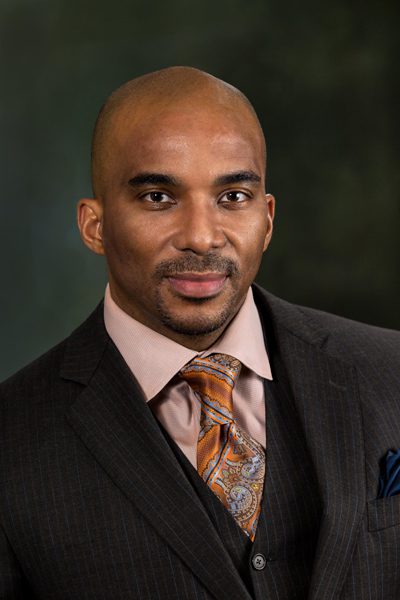Teachers have a great impact on schools’ functionality, and it has become increasingly more difficult to find, hire, and retain teachers that can help play a large role in meeting the changing needs of their schools. Due to circumstances outside their control, leaders have not always been able to equip educators with all the resources necessary for success, which has led to an exhausted workforce. Education and the teaching profession are not what they used to be. Teachers are balancing much more than ever before, and our approach to supporting them should evolve as well.
Discovery Education, AASA, and Voice4Equity joined three experienced educational leaders to share their insights on ways to entice new employees to join (and stay) in their school districts. Continue reading to find five proven ideas for attracting, retaining, and empowering school staff!
Meet the Experts

Dr. Luvelle Brown
Adjunct Faculty, SUNY Cortland & St. John Fisher College in New York
Luvelle Brown is an experienced educator who has held positions as a teacher, assistant principal, principal, school CIO, and Superintendent of Schools. and he has received various awards and recognitions. The 2017 New York State Superintendent of the Year has been listed by TrustED as one of the nation’s top educators and thought leaders. He currently serves as an adjunct faculty member at SUNY Cortland and St. John Fisher College in New York and is a member of Discovery Education’s Courageous Leaders Network.

Dr. Rebecca Andrade
Association of California School Administrators (ACSA) Region 10 Board
Dr. Rebeca Andrade has 25 years of public school experience, ranging from classroom teaching to central office administration. She has served on the California Association of Latino Superintendents and Administrators (CALSA) Board, the Association of California School Administrators (ACSA) Region 15 Board, USC Alumni Board (San Gabriel Valley Chapter), and on the state’s Expanded Learning Division sustainability workgroup. She currently serves on the ACSA Region 10 Board.

Dr. Barbara Mullen
Superintendent, Rush-Henrietta Central School District
A deliberate and confident advocate for all students, Dr. Barbara Mullen is a student-centered leader who always seeks ways for her organization to improve. She has been superintendent of the Rush-Henrietta Central School District in suburban Rochester, New York, since April 2023. Before joining Rush-Henrietta, Dr. Mullen served as the Assistant Superintendent of the Office of Student Services for Cambridge Public Schools in Cambridge, Massachusetts. Dr. Mullen also has served as the Chief of Equity, Culture, and Student Support in Providence Public Schools, Rhode Island.
1. View Education as a Collective Effort
Throughout students’ K-12 journeys, they will interact with a variety of school staff members—administrators, teachers, instructional aides, food service employees, bus drivers, nurses, librarians, volunteers, and more! Viewing education as a collective effort means valuing the roles each staff member plays in a student’s educational path and fostering a sense of belonging in each school. Leaders who are present, encouraging, and aware of changes in the educational landscape foster a sense of inclusivity for their district staff, where every staff member feels their contributions are important.
Leaders’ visibility makes a great difference in the way staff perceive their support. Leaders are also responsible for teaching and learning, so it should be a top priority to visit schools. Dr. Mullen points out that visibility is a free way to build connections with and break down barriers between superintendents and school staff. She recommends that superintendents try to “demystify their role” by visiting campuses and interacting with school staff. Dr. Andrade explained that building a routine of visiting schools is how she remembers why she works in education—she spends Mondays and Fridays visiting schools so she can start and end her week on-site with students and staff.
2. Offer Relevant Professional Learning
Professional learning is critical for all school staff. To ensure PL sessions dive into what matters, Dr. Mullen recommends utilizing a survey to gauge interest in learning and determine which topics energize school-site leaders so that excitement can trickle down. Principal meetings, off-site professional learning sessions, or any time spent away from school buildings, should spark curiosity and inspire innovative practice.
It’s no secret that the teaching profession has changed. With new technology, curriculum, student needs, and systems, the skills needed for a successful teaching career have shifted. While digital tools have created new efficiencies, they are still new and changing, which calls for thoughtful support from leaders as educators prepare to deliver learning with these tools. Dr. Mullen explained that when supported and comfortable, teachers can enhance their own creativity with the help of new technology, but if implementation of new technology is not supported, teachers often feel overwhelmed and see new tools as another task added to their plates. While she loves finding teachers who are up-to-date on new technology, the frequent updates in the EdTech realm call for ongoing support rather than simply hiring a technology whiz for a teacher. Student needs are another part of the teaching profession that have changed, and Dr. Andrade pointed out that the way educators address the needs of multilingual students has changed. In her state, there is a new effort to support multilingual and bilingual students, which calls for bilingual teachers who can support this effort.
To prioritize widespread learning, set district-wide professional learning days. Use your resources wisely by asking teachers to collaborate on designing and planning sessions—they are the best guides for other educators and can share insights into recommended practices.
3. Build a Supportive, Positive Culture
A workplace’s culture can make a major impact when retaining and hiring employees. People want to work where they feel appreciated for their efforts and that what they do matters. For school systems, that means the culture at both the district and school levels must match employees’ values and help employees feel supported. To inspire system and school level change, district leaders must serve as role models that exude the district’s mission and encourage the district employees to continue working toward accomplishing the goals of that mission, while still modeling a healthy work-life balance.

Working in schools is demanding, as employees need to meet a variety of student needs and are more frequently performing in under-staffed conditions. Mindfulness and wellness resources encourage staff to recharge in ways that they find helpful, and leaders should be transparent about why the provided resources were selected. To combat employee burnout, leaders must match the energy and enthusiasm they want to see from staff, while also expressing an understanding of the challenges and stresses staff are under.

4. Give Staff a Voice
In a healthy work environment, transparency goes both ways. Leaders must be clear about goals and their purpose, while staff should be able to share updates on progress, roadblocks, and feel comfortable asking questions. Creating a results-oriented culture offers employees direction in their work, but leaders should encourage feedback and updates on progress toward these results to guide next steps. Dr. Andrade recommends creating an instructional advisory team that is open to all district employees to help foster an open dialogue about challenges and successes. She explained that this advisory team also helps her get to know different district employees that she may only see once or twice in a school year otherwise. Dr. Mullen cites a staff engagement survey as a fantastic tool for gauging employee concerns, morale, and changes. She stated that spending six to seven hours a day at work can only feel fulfilling when the work is in harmony with an employee’s core needs, passions, and values, and she attributes the staff engagement survey as a necessity for understanding her employees’ motivations.
5. Create Strategic Partnerships
Find communities within your community that can help recruit staff and strengthen pipelines of potential employees. Consider how partnerships with local higher education or adult education centers can offer opportunities for your district to connect with students earlier in their career journeys, rather than simply participating in job fairs for recent graduates. Community colleges and universities can offer great long-term partnerships through residency programs for students interested in the education field, as they can help generate a pipeline of skilled students by connecting them with schools for field experience.
Families can also serve as partners in employee recruitment, as many parents may be interested in working where their children attend school or in a similar schedule to their school-age children.
When leaders equip school staff with what they need, they can perform, grow, and create positive change the way leaders hope they will. Believe in the promise of your staff. Stay tuned for more webinars from Discovery Education on the latest buzz in education!


